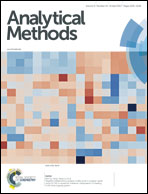Rapid detection of Pericarpium papaveris in hot pot condiments using thin-layer chromatography and surface enhanced Raman spectroscopy combined with a support vector machine
Abstract
A novel multidisciplinary method for the detection of Pericarpium papaveris in hot pot condiments was put forward using the QuEChERS (quick, easy, cheap, effective, rugged, and safe) with thin-layer chromatography and surface enhanced Raman spectroscopy (TLC-SERS). In this study, papaverine and noscapine were detected to indirectly identify Pericarpium papaveris in hot pot condiments, because they are the major components of pericarpium. The feasibility of using the QuEChERS method for detection using TLC-SERS was evaluated. Derivative spectra (the first derivative spectra and the second derivative spectra) were used to reduce the interference resulting from the QuEChERS process and TLC-SERS via a support vector machine (based on particle swarm optimization). The limits of detection for noscapine and papaverine in hot pot condiments were 3 mg kg−1 and 0.5 mg kg−1, respectively. Employing this proposed strategy, the analytes in complex matrices were detected rapidly and sensitively. Moreover, it can be widely applied to detect the analytes in food.



 Please wait while we load your content...
Please wait while we load your content...